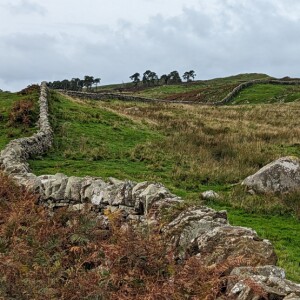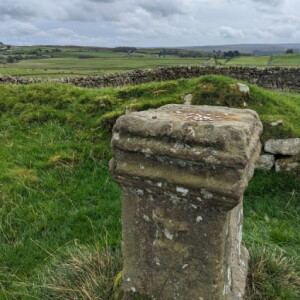Quiet Places
We spent the day seeking silence and finding stones. Being this close, we made a pilgrimage to the wall, heading for as remote and deserted a section as we could find, without too much travel. A missed turning meant we fell unexpectedly upon these - erected many centuries before the coming of the wall-makers. The are called the 'mare and foal stones' but, in reality, they are the remnants of a small stone circle. Very little else seems to be known about them; they are described as 'bronze age', which is a time-window of almost 2000 years - anything from 2000 to 4000 years ago
Our walk took in a stone quarry - now a small lake with a lone swan. We crossed and followed many stone walls, some of them built on the stone foundations of the Roman wall. We looked at tumbled stone remains of forts and milecastles and turrets. We encountered what has been identified as a stone 'altar' from the Roman period; as others have done, we left coins as offerings and we called upon the blessings of the gods for the bride and groom. Looking at the carving on the side of the altar-stone, I think it is a jug of the type the Romans used to serve wine; I wonder if we have entrusted the happy couple to the lifetime protection of Bacchus? I'm sure it will be fine!
From a different era, we found an imposing lime kiln, set amid the remains of the quarry that had provided it with limestone - but looking for all the world like an amphitheatre. Amusingly, some corners of the Internet have declared it to be Roman. In reality it is almost certainly early 19th century, when local production of lime for application to farmland became common, and before large-scale commercial production and effective transport rendered local production uneconomic
I wish I had time and space to write about an infuriating exhibition about 'landscape', at the futuristic, new National Park visitor centre, that manages to gloss over - or miss completely - all the major contemporary issues relating to the subject: the lack of access/right-to-roam; the concentration of ownership in privileged hands; over-representation of landowners in our parliament; privileged taxation of land; subsisdisation of practices that damage landscape; over-grazing by sheep and cattle - the continuing destruction of forests; the biodiversity desert that is much of upland Britain; the evisceration of bodies charged with environmental and wildlife protection...and so on. By the end, I was looking around for rocks to cast at the exhibits, but luckily none came to hand
The extras will have to be removed after a while




Comments
Sign in or get an account to comment.


